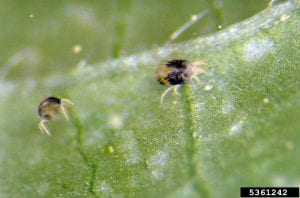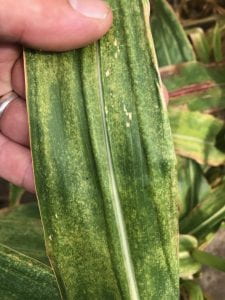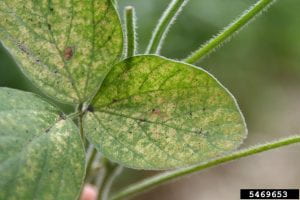NYS IPM Weekly Field Crops Pest Repot-August 28, 2022
Two Spotted Spider Mites in Corn and Soybeans
There have been a few reports this season of spider mites in both corn and soybeans. Spider mites are an issue in hot-dry seasons like the one we are having. Spider mites are minute and very hard to see. They look like a speck crawling around on the plant. It is best to look at them with a 10X hand lens to make sure.
Damage
Spider mites can cause yield losses in both corn and soybeans when infestations are high. They have piercing sucking mouth parts. The mite inserts the mouth-parts into the cell wall and sucks out the material from the cell. They reduce the leaf’s ability to produce food for grain fill. The symptoms appear as stippling on the leaves. They can also cause corn to dry down early and may affect silage quality and yield. Spider mites can cause up to 60% yield losses in soybeans when attacked at late vegetative to early reproductive stages. In very severe cases they can eliminate all yield in soybeans.
Monitoring
To collect and view the spider mites, place a white piece of paper under an area you want to sample. Shake the leaves so the mites fall onto the paper. You will see tiny specks crawling on the paper. You can use a hand lens to look and identify them. These are most likely Two Spotted spider mites. Since the mites are generally on the underside of the leaf look for webbing as well. The two spotted spider mite has a life cycle of egg, larvae, two nymphal stages and then an adult. Spider mites will over-winter on grasses in field edges as well as in alfalfa.
Thresholds
There are no research thresholds for determining the economic injury level for soybeans. There are some suggested thresholds. The University of Minnesota suggests the following guidelines for soybeans:
Infestation scale: 0 to 5
| 0 | No spider mites or injury observed. |
| 1 | Minor stippling on lower leaves. No premature yellowing observed. |
| 2 | Stippling common on lower leaves. Small areas with yellowing on scattered plants |
| 3 | Spray threshold: Heavy stippling on lower leaves with some stippling progressing into the middle canopy. Mites present in the middle canopy, with scattered colonies in the upper canopy. Lower leaf yellowing is common, and there’s some lower leaf loss. |
| 4 | Economic loss: Lower leaf yellowing is readily apparent. Leaf drop is common. In the middle canopy, stippling, webbing and mites are common. Mites and minor stippling present in the upper canopy. |
| 5 | Lower leaf loss is common, with yellowing or browning moving up the plant into the middle canopy. Stippling and distortion of the upper leaves are common. Mites are present in high levels in the middle and lower canopy. |
Source: Managing spider mite on soybean
Colorado State University suggest “that if the bottom 1/3 of the of the corn plants shows visible damage and the mites are present in the middle 1/3 of the plant you should treat the field.”
Management
Two spotted spider mites have a tolerance to several insecticides such as a pyrethroid. Many times, when a field is sprayed for any insect pest in corn or soybeans you can get a severe outbreak of spider mites. Natural enemies are a VERY important factor for keeping spider mites at a lower level. Spraying eliminates all these natural enemies causing a spider mite outbreak. If a miticide is used make sure that it is effective at killing the pest.
References:
Managing Spider Mites in Corn and Soybean
Identifying Spider Mite Damage and the Species Responsible
Managing spider mite on soybean
Soybean Vein Necrosis Virus
There have been a few reports of soybean that have Soybean Vein Necrosis Virus. This disease is transmitted by thrips feeding on the plants. Once the plants have the virus there are no management options. For more information, view the following website: https://content.ces.ncsu.edu/soybean-vein-necrosis-virus
Western Bean Cutworm
Western bean cutworm flights have declined for 2022. The peak flight was the 1st week in August. The traps have been removed from fields. This will conclude trapping efforts for 2022.
For more information, view the following website: https://cals.cornell.edu/field-crops/corn/insects-corn/western-bean-cutworm
Interactive Pheromone Trapping Map
Fall Armyworm
Fall armyworm moth captures have been low all season. While fall armyworm was not an issue this year it is important to monitor this pest as well as others in this manner. It helps us know if the pest is here and at what populations. For more information, please view the following website: https://extension.entm.purdue.edu/fieldcropsipm/insects/fall-armyworm.php
Potato Leafhopper in Alfalfa
Potato leafhopper (PLH) infestations have been low this week. It is interesting because in hot dry years PLH is normally an issue in alfalfa. Continue to watch these PLH in alfalfa for potential increases.
For more information on thresholds and management, view the following video:
IPM for Potato Leafhopper on Alfalfa
Soybean Aphids on Soybeans
Soybean aphid populations have been low this last week. Make sure to continue to scout for the aphid until the R6 stage of growth. Natural enemies play a major factor in controlling soybean aphids. This may be one of the reasons we have not had large infestations this year. For more information, view the following website: https://cals.cornell.edu/field-crops/soybeans/insects-soybeans/soybean-aphid.



